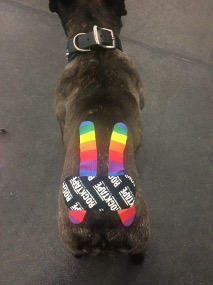Laurie's Blogs.
Jul 2024
Kinesiology Taping – Do You Really Need to Know What You’re Doing?

Today I want to dive into kinesiology taping / K-taping / kinesiotaping. More importantly, is it imperative that you follow the various taping rules in order to make an impact on postural control, proprioception, and/or joint positional sense?
I found a couple of papers that looked at kinesiology taping compared to placebo taping (aka random taping that didn’t follow rules or taping with more rigid tapes).
The first study was a RCT that looked at kinesiology taping (for a purposed) compared to placebo kinesiology taping. Both improved postural control in ACL reconstruction patients. It appears that the changes in postural control may be more related to proprioceptive enhancement due to kinesiology taping rather than the specific kinesiology tape pattern.1
One systematic review / meta-analysis that looked at the effects of functional or biomechanical bandages, whether elastic or inelastic, in Chronic Ankle Instability. In reviewing 28 studies, the authors concluded “all biomechanical or functional bandages, whether elastic or inelastic, applied in chronic ankle instability were favorable, highlighting patient perception, dynamic and static balance, kinematics and agility and motor control, for its effectiveness and evidence. The meta-analyses found no statistical significance.”2
A third study evaluated joint positional sense (i.e. the patient’s ability to reproduce a specific joint angle), with patients using kinesiology tape compared to rigid tape. The researchers found that within-group differences at any two time points were not statistically significant and there were also no significant differences between the groups. So they proclaimed that the kinesiology taping had no effect on knee joint proprioception.3 (Could it have been that both taping methods had an impact? We don’t know, since they did not have a an untaped group.)
The Conclusions from them all?
Kinesiology taping might help with proprioception, and since placebo taping was just as effective as ‘strategic kinesiology taping’, perhaps it doesn’t matter how you put it on or even the type of tape. Of course in the canine world, we have a bigger issue, and that is the hair. So, are we having any impact at all on proprioception? And how would you even go about testing that in an animal? All in all, more questions than answers!
References:
1. Nazary-Moghadam S, Abbasi Z, Sekandari R, Razi A, Zeinalzadeh A, Rostami S, Khabbaz Kababi MH. Kinesiotaping Is Not Better Than a Placebo: Kinesiotaping for Postural Control in Anterior Cruciate Ligament-Reconstructed Patients-A Randomized Controlled Trial. J Sport Rehabil. 2024 Mar 26;33(4):245-251.
2. Chamorro-Moriana G, Perez-Cabezas V, Benitez-Lugo M. Effectiveness of functional or biomechanical bandages with athletic taping and kinesiotaping in subjects with chronic ankle instability: a systematic review and meta-analysis. EFORT Open Rev. 2024 Feb 1;9(2):94-106.
3. Hadamus A, Grabowicz M, Wąsowski P, Mosiołek A, Boguszewski D, Białoszewski D. Assessment of the Impact of Kinesiology Taping Application Versus Placebo Taping on the Knee Joint Position Sense. Preliminary Report. Ortop Traumatol Rehabil. 2018 Apr 30;20(2):139-148.



